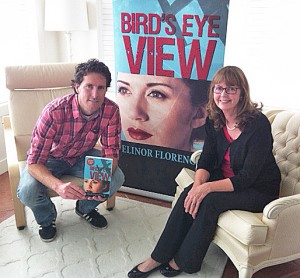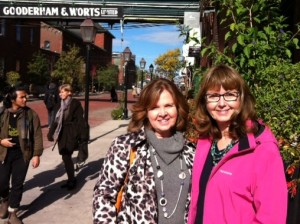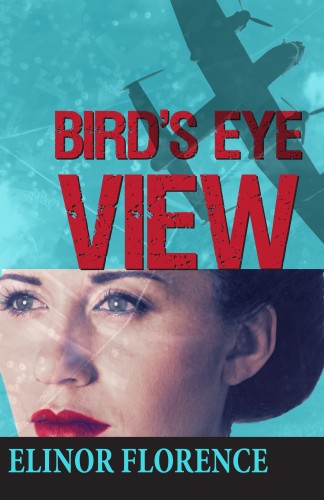Canadian career journalist ELINOR FLORENCE, who lives in the mountain resort town of Invermere, British Columbia, has written for daily newspapers and magazines including Reader’s Digest. Her first historical novel, Bird’s Eye View, was published by Dundurn Press of Toronto (October 2014). Months before her book was released, Elinor began her marketing campaign. Here she explains what she has learned so far about the business of selling books.
Here’s the unvarnished truth, because I assume that’s what you are here for. No matter how good it is, your book will not sell itself. If your aim is to sell — either to make money or simply to share your story with a wider audience — then you must become your book’s best friend, advocate, and business partner.
I don’t know yet how many copies of my book have sold. This trade information remains with my publisher. I do know that the first printing sold out within a month, and a few indie shops that carry my book tell me sales are steady. For one glorious day, my book was ranked as an Amazon best-seller in War Fiction. But I won’t have actual numbers until I receive my first royalty statement later this year.
Through trial and error, I have discovered what works for me — at least, what I think works! There’s a saying that 10 percent of all your marketing efforts pay off, but nobody knows which 10 percent.
1. DO NOT expect (much) help from your publisher.
Other authors warned me, and yet I was still taken aback to find this is true. Mine is a traditional publisher, which gives me two huge advantages. First, buyers know that someone aside from me had confidence in my book. Second, my publisher has placed my book in stores across the country. But most of the responsibility for publicizing my book falls to me. This is no reflection on my own publisher. Too many authors, too many books, too little time — these are today’s realities. Even the most successful authors who make lots of money for their publishers complain about feeling neglected.
2. DO prepare to open your wallet.
 People, there is just no way around it. If you want to sell books, you have to spend money on promotion. All my promotional efforts have been funded by me alone.
People, there is just no way around it. If you want to sell books, you have to spend money on promotion. All my promotional efforts have been funded by me alone.
Australian writer Ian Irvine said it best: “What if you don’t have the money for self-promotion? You could cut some of your discretionary spending (e.g., give up smoking, or drinking, or gambling, or non-essential shopping or travel) for a year, and use the money saved. Can’t give up any of those things, even to succeed as a writer? Then maybe you don’t want to be a writer badly enough.”
3. DO set up a website.
Brace yourself. A professionally designed website with an array of features can cost up to $5,000. I paid much less to my designer, Seattle-based Mark Figlozzi, who offers a special deal called Websites for Writers. My website is www.elinorflorence.com. For me, Mark created a Home Page plus buttons for six other pages: About Me, Book Page, Blog Page, Events Page, Media Page, and Contact Page. He also provided me with instructions for maintaining my own site. You can check out Mark’s services here: Bizango.
At first I was feverish with anxiety whenever I tried to change a photograph or add text. Eventually I got the hang of it, and now I only pester him about once a month for advice.
It isn’t hard to find a website designer. Throw a stick down the street, and you’ll probably hit one. The challenge is to find one who gives you the design you want, and who’ll be there for you down the line if you have problems or want to update your site.
Even the simplest website design will cost a few hundred dollars. At a minimum, you need one static page called a “landing page,” where visitors land when they search for your name or your book. It should include a short biography and a professional photograph, information on your book and how to buy it, and your contact information.
DO check out free website templates, especially if you are reasonably tech-savvy or have a family member willing to help. Some are very attractive.
Here, from Jane Friedman, is The Basic Components of an Author Website.
4. DO NOT start a blog.
I realize this is contrary to what you’ve been hearing, but for more than a year I’ve written a weekly blog, Wartime Wednesdays, which I recently cut back to every other week. I started it because I had accumulated masses of material while researching my book, and a blog seemed a good way to share this. Also, the subject matter of my wartime novel lends itself to a stream of interesting non-fiction topics. If you want to take a peek, it’s here.
Maintaining a blog has paid off in some ways, because I know that many of my blog readers have purchased my novel. But I don’t recommend this avenue to others. My blog exists at enormous cost to me in time and effort. And it is bloody hard work to keep coming up with good material – emphasis on good. Everyone has about ten or twelve good ideas, and then they run out of gas. Your time is far better spent working on your own writing project.
And if you are thinking about writing a blog, please don’t write about writing itself – there are many excellent writing blogs out there, like Allyson’s.
5. DO use free social media.
You can create a free public Facebook page, post content of interest, ask people to Like your page, and share your posts with others. Check out my page called “Elinor Florence – Author” to see what I post. (I have a separate personal FB page for family and friends.)
Last year, I wrote a post for Allyson Latta called Facebook for Writers, with reasons why for me it’s been a great resource.
Since then, however, Facebook has changed its methods. Although my author page has 275 Likes, only about 50 people receive my posts on their newsfeed. That’s because Facebook wants me to pay every time I post something. As an experiment, I’ve tried paying $5 or $10 a couple of times. Then Facebook sends my post to hundreds of people, but I have never seen any bump in Likes or Comments as a result.
Every little bit helps, though. A Facebook page is still a useful landing pad for people who want to know more about you. I also have a Pinterest board for my novel, I tweet once or twice a week, and I have a growing circle of friends on Goodreads. It’s all free, and it’s all part of my “author platform.”
6. DO NOT spend much time on traditional media.
As a former print journalist, I feel sad writing this. But the fact is that when my book was released, I spent weeks preparing and sending out more than one hundred individualized press releases. I was interviewed by several smaller media outlets, but only a few people showed up at my book events as a result of learning about me from a newspaper or radio interview. I’m inclined to believe that my time is better spent connecting with people through social media or writing guest blogs, like this one. You can see my complete list of media articles and guest blogs on my Media Page.
7. DO spend time on your contact list.
Start harvesting email addresses as soon as possible. Fortunately I’m one of those people who likes to stay in touch, so I already had a large circle of high school friends, former colleagues, and extended family members. And over the past year, I’ve made new friends with people who are reading my blog. I did one mass mailout when my book cover was revealed for the first time, and another one several months later when my book was released.
Now when I go to a book event, I send out a personal invitation to everyone in the vicinity, and I ask them to invite their friends. You will find a handful of acquaintances who really love being part of your adventure and who will go out of their way to help. Remember to thank them profusely, and give them an autographed book.
8. DO press the flesh.
Though I consider myself to be an introvert, I can show up if necessary. In fact, I have discovered that I like talking to groups – something that was formerly unthinkable. You must create opportunities to “hand-sell” your book (another word I learned this year). I have visited book clubs (these are great, because I’m preaching to the converted), libraries (less productive for sales, but I still love public libraries), and bookstores.
I prefer to support independent bookstores and will continue to do so, but my highest sales have been at Chapters. There is just so much more foot traffic in the big stores. At a Chapters event, I will sell twenty to thirty books. But don’t overlook other public gatherings — my most successful event to date was my local Christmas Craft Fair, where I sold sixty.
You can’t sit behind the table — you simply must walk around and engage people. Identify yourself as the author. I have found this to be the best opening line: “Hi, I am the author of this new book. May I tell you about it?” Otherwise people think you are just some salesperson. Then I give them two sentences to entice — and pause. If they are interested, they will ask me to continue. If not, they will say no thanks. Most people are pleasant and say things like “Congratulations” and “Good luck.” I wear my wartime vintage outfit, which is a good conversational opening.
Selling your book is tiring. If you are an introvert like me, do not stay with friends when you travel to promote your book. If you do, you will sit up until midnight chatting and drinking wine, and the next day you’ll feel drained. If I spend the evening relaxing in a hotel room, I’m much bubblier at my book event the next day. Extroverts, on the other hand, may feel invigorated by company — and staying with friends is certainly less expensive than a hotel.
9. DO create bookmarks.
I was conflicted about this initially. Does anyone need another bookmark? E-book readers certainly don’t. But I broke down and printed 1,000 bookmarks because they are cheaper if printed in volume, and they have been immensely useful. It’s a great ice-breaker to walk up to someone and hand them a free bookmark. They hold out their hand, they have something to read while you are talking, and then they walk away with a permanent reminder of your book. I like to think that some of the people who didn’t buy a book on the spot will take the bookmark home, check out my website, and possibly buy a paperback or e-book later. Besides, when you are sitting at a table, you can fan out your bookmarks attractively and make the table look pretty!
Please do not design your own bookmark and print it off at home. It will look tacky! And though it’s unfair, people will assume that if you have a terrible bookmark, you wrote a terrible book. That doesn’t make sense, but there it is.
I hired a graphic designer, Harrison McKay of Smoove, based in Vancouver, to create both my book cover (because I didn’t like the one provided by my publisher) and my bookmark.
10. DO buy signed-by-author stickers.
I thought that most bookstores would provide these, but they don’t. Only one Chapters store provided a roll of stickers. The other store owners were happy when I pulled out my own. And customers love them, because they make the book look special. When signing books one day, I forgot to add a sticker to one, and a few minutes later a gentleman returned to my table and said plaintively: “Don’t I get a gold star?”
Also, leave some of your signed books behind at stores with a sticker on the cover. Signed books are perceived to be of more value than unsigned books, and with any luck, so will yours be someday. (Another tip: write the recipient’s name in the book — that way they will be reluctant to lend it or give it away.) My stickers (one inch in diameter) cost $30 for a roll of 1,000. Here’s where I ordered them: http://autographedbytheauthor.com.
11. DO create a banner, if you can afford it.
 I was iffy about this because of the cost ($400), but it has proven to be effective. The banner is eye-catching and draws people when I set it up in a bookstore or other venue. On the few occasions when I have been interviewed for the media, it makes a perfect backdrop. And almost everyone who has their photographs taken with me wants to stand in front of the banner! It’s easy to assemble, packs into a nice little black carrying case, and it’s very portable. I ordered mine through Smoove.
I was iffy about this because of the cost ($400), but it has proven to be effective. The banner is eye-catching and draws people when I set it up in a bookstore or other venue. On the few occasions when I have been interviewed for the media, it makes a perfect backdrop. And almost everyone who has their photographs taken with me wants to stand in front of the banner! It’s easy to assemble, packs into a nice little black carrying case, and it’s very portable. I ordered mine through Smoove.
12. DO learn from the experts.
Here are a few websites that I follow for good marketing advice:
Remember the author above who urged you to spend money? Of all the advice I have read about book promotion, Ian Irvine’s was the most helpful. Happily, he posted his whole guide to book marketing online.
Chip MacGregor is a literary agent in Oregon who writes a useful blog and also publishes a post about marketing each Thursday.
Jane Friedman is a guru of the contemporary publishing world. There are a number of helpful posts in her Archives as well.
Patricia Fry is a self-published author of mysteries and an indefatigable marketer.
Rachelle Gardner, another literary agent, is a popular provider of writing and publishing advice.
One last thing: When people tell me they liked my novel, I always ask them nicely to post either a review or a star rating on Amazon, or on Goodreads, if they are members there. My publisher advised me that readers do look to these reviews when making their buying decisions.
Now, because my goal is always to learn more about book marketing, I welcome YOUR comments and suggestions as well. Please post them below, or visit me. See what I have coming up on my Events Page. If you can’t come to me, I can come to you, via Skype. Book clubs, read Bird’s Eye View and contact me to arrange a virtual author visit.
ABOUT MY BOOK
Bird’s Eye View is the unforgettable story of an idealistic young Canadian woman who joins the air force in the Second World War and becomes an aerial photographic interpreter. Working with hundreds of other intelligence officers at a converted mansion in England, Rose Jolliffe spies on the enemy from the sky. What she sees through her magnifying glass will change the course of history — and her own life — in ways she never imagined. It’s available through any bookstore, or from Amazon.

Allyson Latta and Elinor Florence at Historic Distillery District, during Elinor’s publicity visit to Toronto.


Excellent article, very helpful! I especially like the idea of the banner and sticker.
Thank you, Allyson, for featuring Elinor Florence. Her book, A Bird’s Eye View, drew me in from the start with her heart-felt depiction of the people and land that make Canadians unique, especially in the historical context of WWII. Her reflections on her publishing experience are enlightening, especially from an indie-author’s perspective. It’s tempting to think the grass is greener on the traditional side of the publishing fence, but as we often learn, sometimes those store fronts are made of cardboard.
I appreciated the reminder to rate on Amazon & Goodreads, and followed through as soon as I got home from the Book Club meeting you came out to in New Westminster. It is a real treat to have an author at a Book Club meeting, especially if you really liked the book. It certainly made me purchase a book that wouldn’t have come to my attention otherwise!
Good article and so needed. Marketing is a big problem for most new authors, especially novelists. This is a good reminder for them while offering some great ideas. I feature tons of ideas and perspective for novelists in my book, Promote Your Book (Allworth Press).
Thanks, Elinor, for presenting such a useful piece.
Thanks, Allyson, for this very useful and interesting article by Elinor Florence. We met through her interest in children’s author and naturalist Thornton W. Burgess, the subject of my 2013 biography (Schiffer Publishing); fun to find out her daughter has framed Burgess book covers! Best wishes to you both!
Thanks Elinor,
Some great resources in this piece. One question: you don’t mention book launches. Traditional publishers are increasingly abandoning the book launch because they are expensive and sales don’t cover the expense of holding one (my book is scheduled for publication by Dundurn next spring, and the authors’ notes they sent me says they don’t do book launches). I’m planning on organizing one myself. Do you have any thoughts or experiences to share on this? Worthwhile or not? And if yes, how would you keep down expenses?
Good question, Phil. I was using the terms launch/event/signing interchangeably. The launch is just the first event, but otherwise I don’t think it is different than any other event. In fact, I called my events “Launches” at every new city, as in “Saskatoon Book Launch” or “Red Deer Book Launch” because it’s the first time I had appeared in those cities. I think you can call it whatever you like.
I had my official “Launch” in Toronto just because my cousin’s wife owns Type Books! But I had no publicity, and no attendees other than the people I knew beforehand, except that my Dundurn publicist also attended. Dundurn did not provide any assistance, financial or otherwise.
One tends to think of a “Launch” as a big event, and if you have friends and family who want to celebrate your success, then by all means organize a party and call it a Launch. You worked hard and you deserve it! In my experience, my events have gotten better attended as time goes one, now that more people are reading my book and want to meet me.
Good luck with the book, and I’ll be watching for it!
I would expect that most writers would find this succinct advice hugely helpful – Elinor’s done the work!
Wow, what a great list of advice. Thanks for sharing. I plan to use all of it!